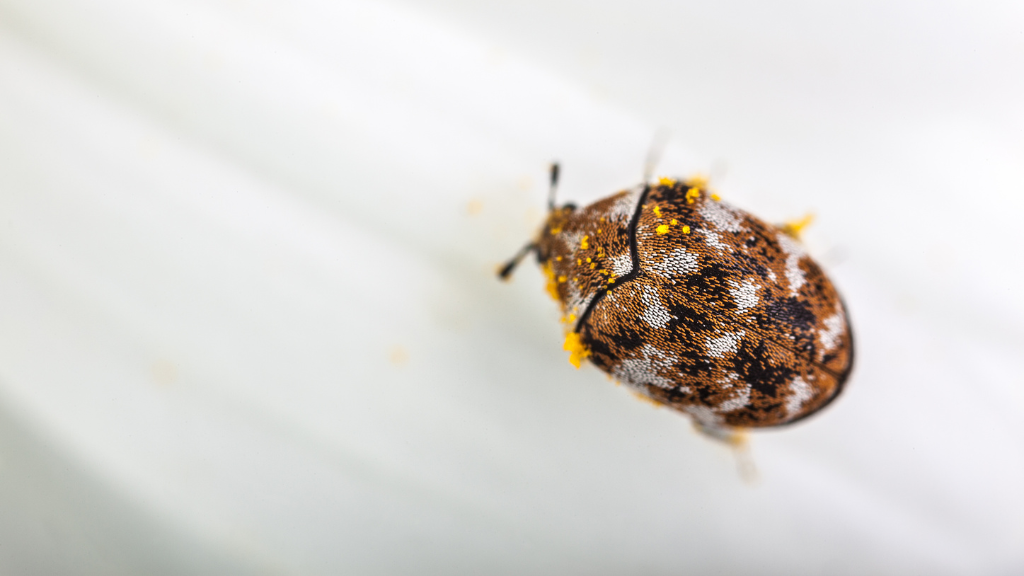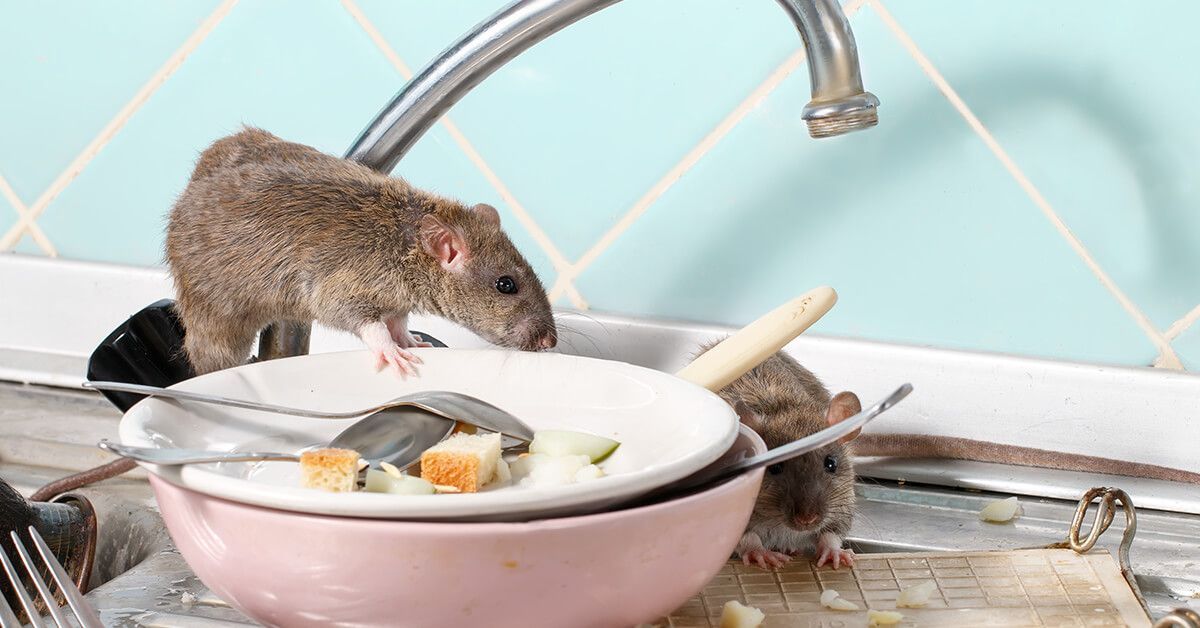Have you ever spotted a small beetle crawling along your curtains, bedding, or carpet? It was likely an aptly-named carpet beetle. They’re common indoor pests that feed and live on fabrics and natural fibers. While they’re unobtrusive, their munching can destroy clothing, bedding, and rugs. Learn how to identify these pests and remove them from your home.

WHAT IS A CARPET BEETLE?
While there are multiple species of carpet beetles, three are notable here in the United States: the varied carpet beetle ( Anthrenus verbasci) , furniture carpet beetle ( Anthrenus flavipes), and black carpet beetle ( Attagenus unicolor). These insects get their common name from their diet: they eat woolen fabric, furs, and other natural fibers. They also lay their eggs in those food sources, making sure that their newly hatched larvae have food to eat.
Once an adult carpet beetle lays eggs, it only takes around two weeks for the eggs to hatch when conditions are right. The common temperature range in most homes is 77–78 degrees Fahrenheit, making it the perfect environment for these pests to thrive.
Carpet beetles feed on nectar and pollen when they’re adults, so you’re more likely to find them outside than inside. They most often eat spiraea, buckwheat, crape myrtle, and other plants with heavy pollen. Larvae do the most damage and seek out tasty treats like:
- Natural fibers
- Wool clothing
- Wool rugs
- Silk
- Dog or cat hair
- Human hair
- Lint
- Cereals
- Pet food
CARPET BEETLE SPECIES
Here’s how to distinguish common carpet beetle species in the U.S.:
VARIED CARPET BEETLE ( Anthrenus verbasci)
WHAT DO THEY LOOK LIKE?
Adult carpet beetles have irregular patterns but are primarily white, dark yellow, and brown. Older beetles might look solid black or brown.
HOW BIG ARE THEY?
Adult varied carpet beetles are around a tenth of an inch long.
WHERE WILL YOU FIND THEM?
Outside, you might see them in spiderwebs or bee or bird nests. They often look for wool, leather, animal skins, and silk when indoors.
WHAT DO THEY EAT?
Adults eat nectar and pollen, but larvae eat a variety of things ranging from beeswax and pollen to whalebone and hair.
LIFE CYCLE INFORMATION
Varied carpet beetles can lay up to 40 eggs at a time. Adults live from two to six weeks if female or two to four weeks if male.
FURNITURE CARPET BEETLE (Anthrenus flavipes)
WHAT DO THEY LOOK LIKE?
Adult furniture carpet beetles are bigger than varied carpet beetles. They are also rounder and look mottled or solid black.
HOW BIG ARE THEY?
Adults are around a tenth of an inch long, but they can be slightly larger width-wise than their smaller counterparts.
WHERE WILL YOU FIND THEM?
They live in the same places as varied carpet beetles: spiderwebs and bird/bee nests when outdoors and on wool, leather, animal skins, and silk when indoors.
WHAT DO THEY EAT?
Adults and larvae also have the same diet as varied carpet beetles.
LIFE CYCLE INFORMATION
Furniture carpet beetles can lay up to 60 eggs at once. Adults live for four to eight weeks.
BLACK CARPET BEETLE ( Attagenus unicolor )
WHAT DO THEY LOOK LIKE?
Black carpet beetles are shiny black or dark brown. They have brown-colored legs.
HOW BIG ARE THEY?
The black carpet beetle is around an eighth to 3/16 inches long.
WHERE WILL YOU FIND THEM?
This kind of beetle is often found in arid areas.
WHAT DO THEY EAT?
Interestingly, this kind of beetle tends to get into stored products like cereals or grains, however, it can also be a carpet pest.
LIFE CYCLE INFORMATION
Black carpet beetles lay up to 90 eggs at once and can live for up to eight weeks.
The most likely reason for having carpet beetles in your home is because your doors or windows have been open (or not properly sealed), and you have flowers or flowering trees in nearby landscaping. Sometimes, an adult beetle might come in on a package or plant that was brought indoors. It’s also possible to unknowingly bring carpet beetle larvae into your home that are hiding in secondhand clothing and rugs.
If you use wool carpets and have leather upholstery or other sources of food, the carpet beetles may stick around to find a place to lay their eggs. On the other hand, if there are no good food sources, many will fly back outside where plants are plentiful.
Prevention is the key to avoiding carpet beetles in your home, so remember that you’ll need to clean susceptible areas and food sources (like rugs, garments, and even certain kinds of piano strings) on a regular basis. Store unused items that would attract carpet beetles in tightly closed containers, like vacuum-suction bags or plastic containers, to minimize the risk of these pests getting to them.
By knowing the reasons behind carpet beetles coming into your home and what you can do to prevent them, you may be able to avoid an infestation completely. However, even your best efforts may not always be enough. If you find that you have a carpet beetle infestation, it’s time to take the next steps to eliminate them.
Carpet beetles aren’t likely to go away unless they run out of food, and since they eat such a wide variety of items, that isn’t likely to happen quickly. Once carpet beetles are inside a home, they’re difficult to control because of how widely they can disperse throughout it.
The good news is that simple steps, like getting rid of the food resources and sanitizing the area, may be enough to prevent them from coming back. If you notice a few adult carpet beetles in your home, remove them as soon as you can. They can be harmful to people with allergies and can cause significant damage throughout your home if they get the opportunity to lay eggs. You can just pick them up by hand and discard them outside, away from your house.
Once the carpet beetles are out of your home, take the time to seal any cracks that might allow them to come back inside. You can use caulk for exterior gaps and weather stripping to close the areas under windows and doors. Use window screens and avoid having flowers or plants close to your windows if they’ll be open. By adjusting the location of flowering plants and minimizing the places where these beetles can enter, they’re more likely to stay outside where they belong.
One of the nice things about carpet beetles is that they’re large enough to see easily. You’ll be able to tell if they’re crawling around on your floors or are popping up in a closet.
Although cleaning is helpful and can help take care of minor infestations, a larger problem is best handled by the experts. If you can’t locate the source of the infestation, it’s likely the carpet beetles will return and continue causing damage. Let our experts at Local Exterminator help you eliminate bothersome pests using our pet- and family-friendly methods.
No one likes to find a pest eating away at their carpets or upholstery. At Local Exterminator, we understand how frustrating it can be to deal with carpet beetles and all the damage they can cause. We’ll help you take steps to seal off points of entry and locate the source of the problem so you can get rid of pests and start relaxing again in your home. Call today for a free quote.




